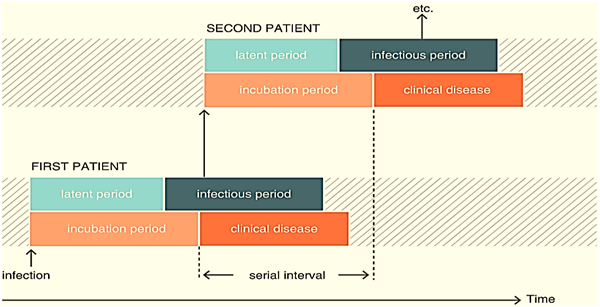‘Serial Interval’in Managing COVID-19
- 18 Sep 2020
According to a recent research paper published in the journal Science - China, which has now gone over a month without any locally transmitted Covid-19 cases, was able to contain Covid-19 due to its ability to manage the ‘serial interval’.
About ‘Serial Interval’
- The serial interval is the duration between symptom onset of a primary case and symptom onset of secondary cases (contacts) generated by the primary case.
- In simple terms, the serial interval is the gap between the onset of Covid-19 symptoms in Person A and Person B, who is infected by Person A.
- Serial intervals can vary widely, especially for some lifelong diseases (HIV infection, Chickenpox, Herpes).
- The serial interval for SARS was 7 days.
- For COVID-19, a review of the published literature shows serial interval estimates to be 4-8 days
History
- The term was first used by British physician William Pickles, who had initially referred to it as transmission interval with reference to a hepatitis epidemic in the United Kingdom during 1942-45.
- Later, another British physician RE Hope Simpson used the term serial interval, defining it as the interval between successive illness onsets.
Factors on which Serial Interval Depends
The serial interval depends on other epidemiological parameters such as the incubation period, which is the time between a person’s exposure to the virus and symptom onset, and the reproduction rate or R naught, the number of people who will be infected by one infected person.

Source: Springer link
Significance
- The serial interval helps to gauge the effectiveness of infection control interventions besides indicating rising population immunity and forecast future incidence.
- Thus, the more quickly persons who contracted Covid-19 are identified and isolated, the shorter the serial interval becomes and cuts down opportunities for transmission of the virus.
- To manage serial interval, a robust system of contact tracing, quarantine, and isolation protocols should be in place.
Examples
China
- The serial interval in Wuhan came down from 7.8 days to 2.6 days between early January and early February.
- Quarantining contacts within 1 day from symptom onset helped reduce Covid-19 transmission by 60 per cent.
South Korea
- The serial interval in South Korea was estimated to be 3.63 days.
- This was made possible due to aggressive contact tracing, quarantine, and isolation, thereby ensuring that infected patients, because they were isolated, could not infect any more people later in the infection cycle.
- Other interventions such as suspension of intra- and intercity travel, and different forms of social distancing widely implemented in different Chinese cities kept the serial interval low.




